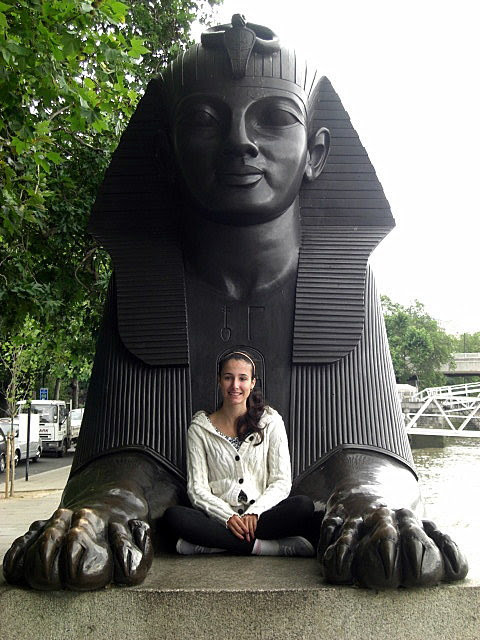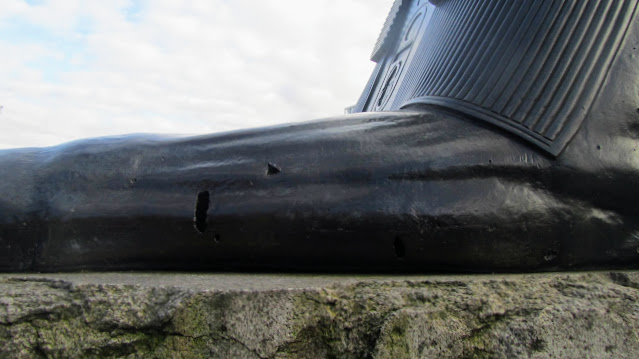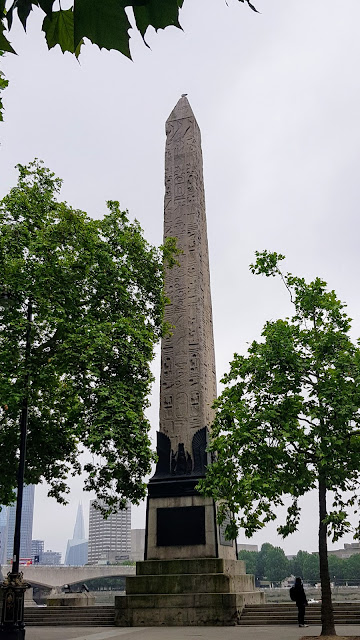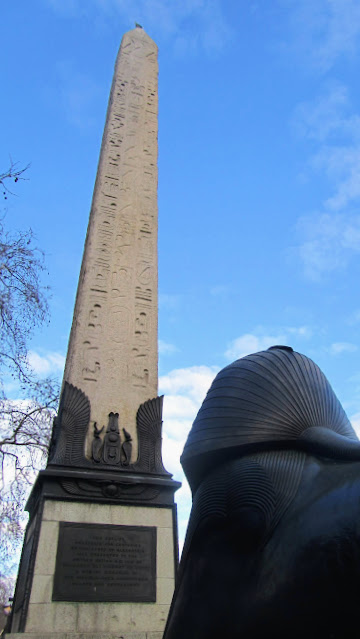 |
| A piece of Egypt in London. |
As you walk along the Victoria Embankment, outside of the quaint Victoria Embankment Gardens, there stands an Egyptian Needle made of granite.
It is flanked by two bronze fake Egyptian sphinxes, which stare towards the needle, rather than having their backs to it in a typical guarding posture. This, apparently, was due to an error when they were installed.
 |
| My eldest, Alysha, sits with the undamaged sphinx. |
 |
| Shrapnel Damage. |
Also, the benches along the Victoria Embankment have winged sphinxes as armrests, which adds even more of an Egyptian feel to the area.
 |
| One of the Egyptian styled benches that can be found along Victoria Embankment. |
 |
| This bench uses Camels as the armrests. |
Brief History
This obelisk is often called Cleopatra's Needle, but it is actually from the reign of Thutmose III (1479–1425 BC). Cleopatra reigned from (51–30 BC). The obelisk was a gift from the ruler of Egypt and Sudan, Muhammad Ali, in 1819, in commemoration of the victories of Lord Nelson and Sir Ralph Abercromby at the Battle of the Nile in 1798 and the Battle of Alexandria in 1801, respectively.
The British government, of the day, liked the idea of the gift, but refused to fund the transportation costs.
 |
| Still standing after more than 3000 years. |
The obelisk was first erected in around 1450 BC in the Egyptian city of Heliopolis, on the orders of Thutmose III, and had inscriptions carved on each face.
Ramesses II added more inscriptions to commemorate his military victories, some 200 years later.
Ina around 12 BC the obelisk was moved by the Romans, to a temple in Alexandria, to honour Julius Caesar. Some time later the obelisks were toppled and left in the sand, which actually helped to preserve the hieroglyphs.
 |
| A Sphinx keeps an eye on the Needle. |
The obelisk wouldn't move again until 1877, when Sir William James Erasmus Wilson sponsored its move to London. Working with Mathew William Simpson, an engineer, the obelisk was removed from the sand and encased in an iron cylinder, which had been designed by John Dixon and built at the Thames Iron Works, before being shipped to Egypt in pieces.
The cylinder had a rudder, a mast for balancing sails, and a deck house and had six crew including Captain Carter. The floating cylinder was named 'Cleopatra'.
This floating pontoon was to be towed to London by the Captain Booth's ship 'Olga'.
As they they sailed through the Bay of Biscay they were caught in a storm and the 'Cleopatra' began to roll wildly. Captain Booth dispatched a boat with six seamen aboard to rescue Captain Carter and his crew. Unfortunately, the boat capsized and all six men were lost.
Captain Booth managed to get the 'Olga' close enough to the 'Cleopatra' to rescue Booth and his men, leaving the cylinder to sink.
Four days later Spanish trawlers spotted the 'Cleopatra' still afloat and, with the help of the Scottish steamer 'Fitzmaurice', towed it to Spain for repairs.
The William Watkins Ltd paddle tug 'Anglia', under the command of Captain David Glue, was commissioned to tow the 'Cleopatra' to London.
They arrived on January 21, 1878.
 |
| The Needle as seen from the River Thames. |
On September 12, 1878, the 186-ton, 60 foot, obelisk was finally erected along the Victoria Embankment, which was not to have been its original home. Originally it was to have been erected outside the Palace of Westminster, but this idea had been rejected due to the ground at the chosen site subsiding.
The names of the six seamen who lost their lives have their names on a bronze plaque attached to the needle's mounting stone.
The mounting stone also had a time capsule placed inside, which contained that morning's newspapers, a set of coins, four bibles in different languages, Bradshaw's 'Railway Guide' and photographs of 12 of the best-looking Englishwomen of the day.
There are similar obelisks in Paris and New York.
No comments:
Post a Comment